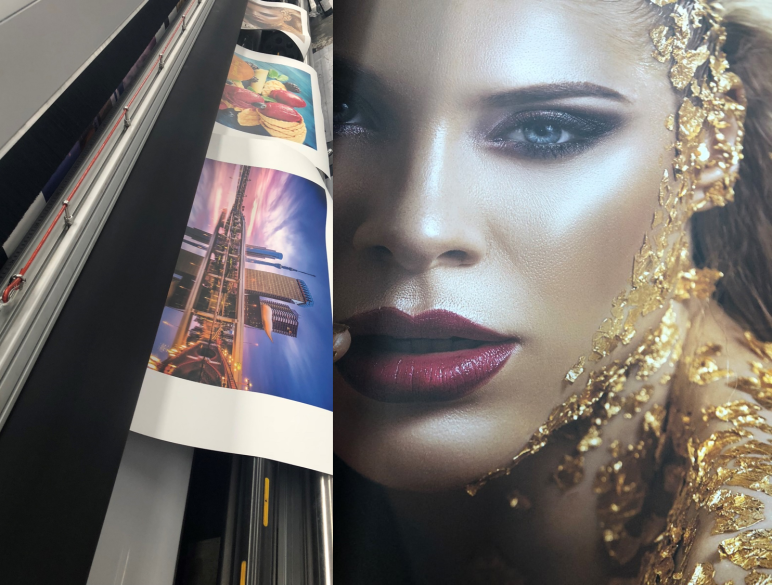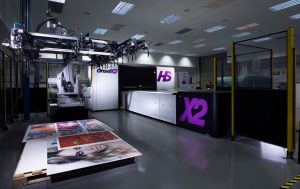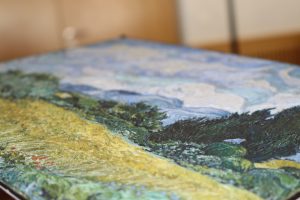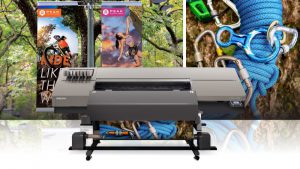
A world of posters, pull-ups and point-of-sale paraphernalia beckons the minute we step outside our front doors and the industry is transforming from producing fine print to generating large – often gigantic – visuals.
Beyond signage is the lucrative new realm of printing fixed infrastructure – from bus shelters and building wraps to wall menus and wallpaper at restaurants.
The possibilities and profitability are limited only by the imagination.
Some of Australia’s top wide format equipment vendors have shared their ideas with ProPrint.
Photo Electronic Services (Durst)
Matt Ashman of Photo Electronic Services and sales manager for the Durst range in Australia, sees fabric and soft signage as a powerhouse of potential for print businesses looking for new profit sources. He identifies a plethora of new opportunities, such as printing with green credentials, low power consumption, locally produced print on recyclable media, fewer synthetics, more sustainable print on demand rather than print on consignment, which is highly wasteful, and many ways “to work smarter, not harder”.
Ashman says the latest in the Durst line-up is the Durst P5 250 HS device, a printer that can produce up to 600 square metres of saleable product with low power consumption and a small footprint, compared to other machines that produce at this speed. “The machine’s technology is focused on less wastage and more efficiency, with dedicated Durst workflow and hardware that only need purging once a week, compared to the norm of many competitive devices that purge litres of ink each day.”
Epson Australia
According to Gordon Kerr, business marketing manager at Epson Australia, print businesses looking for new fields to play in should be focusing on soft and hard signage, film and fabric. Kerr sees décor, awnings, sun shades, wall finishes and cabinetry as profitable new avenues, alongside merchandise, phone covers and photo imaging. In the point of sale sector, he predicts a strong and growing future for displays, wall and floor decals, as well as vehicle decals and skins.
“What producers need to do is ensure their product remains relevant; they need to use images that excite – and print using inks that are bright and punchy. They need to ensure their product remains cost effective, and they need to look at their equipment and workflow to ensure production costs are minimised. They need to look at new mediums to ensure their product is attractive and different, for example, transition from board to reflective film, from paper to backlit film, from self adhesive vinyls to canvas and fabric,” he says.
What kind of equipment does Kerr recommend for a print company to kit itself out for the leap into wide format? “If anything one of the fastest transitions is away from print proofing; it is becoming increasingly important that producers adopt a colour managed workflow so that the electronic proof that their customer is referencing can be accurately reproduced. Each print needs to look exactly as it was intended, from the small in-store poster or point of purchase piece, to a large window decal, outdoor bus or billboard display.
Kerr says Epson has one of the widest ranges in the large format print market.
“We provide equipment to enable production of everything from boutique photos and fine art to precision colour graphics, indoor point of sale and posters, durable outdoor signage, merchandise and t-shirts, and high-volume roll-to-roll fabric.”
Fujifilm
Ashley Playford, business manager – digital print systems at Fujifilm, says as the market continues to evolve those who invest in today’s high speed technology will benefit the most.

“The market is rapidly evolving and for Fujifilm the focus is on the high volume side of the market,” Playford said.
“While it is becoming easier to enter the wide format space your cost to produce will be relatively high when compared to the volume producers.
“I strongly believe that those who invest in the high speed machines of today and tomorrow will benefit most from the technology advances as they will be able to produce more for less cost and be in a position to make greater margins.”
Playford says great advances have been made in ink chemistry with a dedicated ink now available for the Onset X.
“We are now able to offer a dedicated plastic ink – Uvijet OX for our Onset X platform,” Playford said.
“This allows large volume plastic producers the ability to run their machines at full speed and opens up further opportunities to increase their margins thanks to OX’s excellent adhesion onto lower grade plastic stocks.”
Playford adds that in conjunction with this new ink, Fujifilm has also just introduced the Onset HS which is a productivity upgrade to the X2 and X3.
“Onset X3 HS is now capable of producing up to 1,450 square metres per hour which is further pushing the boundaries of this high volume market,” he said.
“The Onset X2 HS produces 815 square metres which means from a productivity perspective it’s very close to the standard Onset X3 however comes with a cheaper price tag.
“All of these speed increases come with the same high resolution near offset quality.”
HP
The HP Scitex 17000 is an upgrade on the popular 15000 and offers higher levels of productivity, with a rated speed up to 1,000 square metres per hour.
It uses HP’s HDR technology and prints on coated media using HDR Scitex inks for cost-effective corrugated packaging printing.
Hands-free operation, automated feed, and zero setup further enhance productivity. HP says the press operates smoothly on industrial-grade corrugated board, and the addition of an HP Scitex
Corrugated Grip makes short work of warped media. Hands-free and stack-to-stack operation, as well as automatic loading, further raise the profile of the 17000 as an attractive wide-format investment.
Mimaki Australia
Brad Creighton, national marketing manager of Mimaki Australia, identifies impressive growth in industrial printing markets.

Creighton says Mimaki is developing its concept of Digital Printing Connection to incorporate inkjet printers, formerly used alone, into production lines, for unattended on-demand production and mass-customisation, using communication with peripheral equipment.
The technology employs the use of robots, belt conveyors, inspection devices, various sensors as well as pre-processing and post-processing devices in its functioning.
He says that in the industrial/textile market segments, the equipment not only has to produce results on various materials and fabrics, but the ink solution can benefit from extra levels of certification.
“Mimaki has developed ink platforms that are market-specific and reduce environmental impact.
“For textiles, we have certification by OEKO-TEX, which authenticates the safety of chemicals used during the production of textile dyes, pigments and finishing agents.
“For industrial markets, our LED UV technology and ink platforms have Greenguard certification.
“This ensures that a product has met some of the world’s most rigorous and comprehensive standards for low emissions of volatile organic compounds (VOCs) into indoor air, and is acceptable for use in environments such as schools and healthcare facilities.”
The latest in Mimaki’s line is its JFX200-2513EX.
This is a successor model to JFX200-2513, which has been a large flatbed LED UV inkjet printer on sale since 2013.
The JFX200-2513EX is capable of directly printing on a wide variety of materials, including white board, transparent/coloured board, wood, cardboard and metal with a size of up to 2500mm x 1300mm, and is widely used for various applications, such as sign panels, displays (furniture) and building materials.
“The most dynamic product we are seeing serious growth in is our UCJV300 Series of LED UV printer/cutter models,” says Creighton.
“It has the benefit of Greenguard certification, super-wide media choice and up to five layers of simultaneous printing functionality.
“The new ID Cut enables the printing of identification marks where the cut data can be stored and referenced by an identification mark when ready for cutting.
“Multiple jobs can be referenced autonomously by the detection of our ID mark.”
Neopost
Morgan Quinn, national sales manager – wide format, Neopost, says “We see great opportunities for our customers in new emerging niche markets. Advancements in digital printing truly have opened up potential applications. Short-run custom packaging, interior décor and retail – point of sale and point of purchase are all strong markets we are seeing growth in. New technologies are allowing greater applications. New primers and coatings are allowing digital printing to be done to more and more surfaces.”
What equipment a business utilises is linked to the applications they are looking to produce and markets they are looking to print for. The volumes they are looking to produce, the materials they want to print to and sizes will all play a key role in what sort of equipment is needed, he says.
“An often overlooked element in production can be finishing. Printing it is one thing but getting the product finished suitably and out the door can often lead to bottlenecks. Our customers who utilise finishing options like Fotoba XY cutters and Aristo flatbed cutting tables often find that they can’t live without them once they have been integrated into their production floors.”
Océ Australia
Garry Muratore, product manager, graphic arts, for Océ Australia, believes UV ink technologies offer the best ways to exploit new applications. “With superior adhesion qualities, printing on glass, acrylics, metal, wood, and so on, becomes easy and achievable,” Muratore says.
Proving this point, Muratore says, was last year’s Océ Arizona Print Awards, with two of the three major prizes awarded to applications utilising glass as the media. “In the roll-to-roll printer space, Océ UVgel has allowed media such as thin foils and papers to be used – typically these types of media prove problematic in older latex or eco-solvent technologies due to the potential to deform from heat generated by the drying process,” he says. “Océ’s UVgel on the other hand utilises LED UV lamps to cure the ink. This takes place in a low temperature environment, making it perfect for heat-sensitive media types.”
The Océ line-up comprises the flatbed UV printer segment where the Océ Arizona range continues to be a sales leader, Muratore notes. “This award winning range of printers extends the fourth-generation design of the world’s best selling mid-volume flatbed printer range even further in terms of print capacity,” he said.
A new member of the Océ Arizona family, the Océ Arizona 1300 series, was unveiled at the recent opening of a new Customer Experience Centre in Melbourne. Muratore said the Océ Touchstone technology works with the Arizona range giving printers the edge with sophisticated and easy-to-use elevated printing technology to target new, high-end markets. Océ’s Colorado 1640, Océ’s first printer based on the Océ UVgel technology platform, is the world’s first 64-inch production printer, he notes.
Ricoh Australia
Henryk Kraszewski, senior product manager, commercial and industrial print, at Ricoh Australia, says that although the signage and graphics market is mature – and flat – there are still opportunities for growth. One area is latex printing, growing rapidly due to the environmental benefits and faster turnarounds that the technology offers – as well as the ability to print on a broader array of substrates.

“Beyond signage and graphics, labels and packaging, décor and textile printing are sectors of the print industry that are growing rapidly,” he says. “As industries transform from analogue to digital processes, the benefits of digital wide-format printing come to the fore – time to market, short runs, personalisation, design flexibility, stock reduction, eco-friendliness and so forth,” he states.
Kraszewski says growth areas are textile printing and labels and packaging, but new applications have focused particularly on the décor market – the ability to deliver solutions for building materials, interior materials, industrial goods, household appliances, and furniture.
“The ability to print on almost any substrate – wood, glass, acrylic, steel, aluminium, MDF, PET, paper, and so on – provides the opportunity to produce an array of new applications.”
Examples of this include interior applications of wallpaper, window films, blinds, curtains, carpets and rugs. Furniture and household applications of tables, wardrobe and kitchen doors, splashbacks, bathroom units and air-conditioning covers are other examples. It can also be used to produce building materials including flooring, fittings and decorative finishes.
Kraszewski says wide format latex printers can print on a wide range of materials, offering outstanding image quality and print speed while being easy to operate and maintain. They also offer environmental benefits, which he lists as low energy consumption, odourless printing, and low ink consumption. UV flatbed printers provide the flexibility to print on an almost limitless array of rigid material, including wood, MDF, glass, steel, aluminium, acrylic, resin, PET and boards.
Kraszewski says Ricoh has just released a new family of wide format solutions. The range leverages Ricoh’s more than 45 years of expertise in inkjet technology.
The new solutions feature Ricoh industrial print heads, Ricoh ink technology and include the Pro L5160 wide format roll-to-roll printer with AR latex ink; the Pro TF6250 UV flatbed printer; and the Pro T7210 UV flatbed printer. “The new printers offer best-in-class print performance, image quality, substrate flexibility, ease of use and ease of maintenance. The combination of new Ricoh wide format printers covers all bases in the new and growing wide format markets. They also all feature the ability to utilise white ink to cater for the label and packaging market. This is a unique capability for the Pro L5160 with white latex ink in the roll-to-roll market.”
Comment below to have your say on this story.
If you have a news story or tip-off, get in touch at editorial@sprinter.com.au.
Sign up to the Sprinter newsletter
